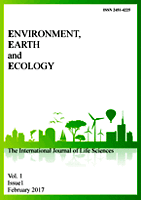| 1. |
Artis DA, Carnahan WH (1982) Survey of emissivity variability in thermography of urban areas. Remote Sens. Environ, 12, 313–329.
|
| 2. |
Akbari H, Rosenfeld A, Taha H, Gartland L(1996) Mitigation of summer urban heat islands to save electricity and smog. In 76th Annual American Meteorological Society Meeting Atlanta, GA.
|
| 3. |
Akbari H, Pomerantz M, Taha H (2001) Cool surfaces and shade trees to reduce energy use and improve air quality in urban areas. Solar Energy, 70, 295–310.
|
| 4. |
Becker F, Li ZL (1990) Towards a local split window method over land surfaces," Intern. J. Remote Sens., 11, 369-393.
|
| 5. |
Barsi JA, Schott JR, Palluconi FD, Helder DL, Hook SJ, Markham BL, Chander G, O’Donnell EM (2003) Landsat TM and ETM+ thermal band calibration. Canadian Journal of Remote Sensing, 29(2), 141-153.
|
| 6. |
Bretz S, Berdahl P (1997) Preliminary survey of the solar reflectance of cool roofing materials. Energy Build, 25, 149-158.
|
| 7. |
Chen ZM, Babiker IS, Chen ZX, Komaki K, Mohamed MAA, Kato K (2004) Estimation of interannual variation in productivity of global vegetation using NDVI data. International Journal of Remote Sensing, 25 (16), 3139−3150.
|
| 8. |
Carnahan WH, Larson RC (1990) An analysis of an urban heat sink. Remote Sens. Environ, 33, 65–71.
|
| 9. |
Carson TN, Gillies RR, Perry EM (1994) A method to make use of thermal infrared temperature and NDVI measurements to infer surface soil water content and fractional vegetation cover. Remote Sensing Reviews, 9, 161-173.
|
| 10. |
Dash P, Göttsche FM, Olesen FS, Fischer H (2002) Land surface temperature and emissivity estimation from passive sensor data: theory and practice-current trends. Intern. J. Remote Sens., 23, 2563-2594.
|
| 11. |
EOSAT Landsat Tech. Notes., 3-8.; Oke TR (1982) The energetic basis of urban heat island. J. R. Met. Soc., 108, 1-24.
|
| 12. |
Gallo KP, McNab AL, Karl TR, Brown JF, Hood JJ, Tarpley JD (1993) The use of a vegetation index for assessment of the urban heat island effect, Intern. J. Remote Sens., 14, 22232230. Gallo, K.P., and T.W. Owen, 2002: A sampling strategy for satellite sensorbased. Intern. J. Remote Sens., 23, 1935-1939.
|
| 13. |
Gillies RR, Carlson TN (1995) Thermal remote sensing of surface soil water content with partial vegetation cover for incorporation into climate models. Journal of Applied Meteorology, 34, 745-756.
|
| 14. |
Gibbons DE, Wuckelick GE (1989) Application of LANDSAT thematic mapperdata for coastal thermal plume analysis at Diablo Canyon. Photogramm. Eng. Remote Sens., 55, No. 6, 903909.
|
| 15. |
Hu Y, Jia G (2010) Influence of land use change on urban heat island derived from multisensor data. Int. J. Climatol., 30, 1382–1395.
|
| 16. |
Larson RC, Carnahan WH (1997) The influence of surface characteristics on urban radiant temperatures. Geocarto Int., 12, 5-16.
|
| 17. |
Markham BL, Baker JK (1985) Spectral Characteristics of the LANDSAT Thematic Mapper Sensors. Intern. J. Remote Sens., 6, 697-716.
|
| 18. |
Myneni RB, Dong J, Tucker CJ, Kaufmann RK, Kauppi PE, Liski J, Zhou L, Alexeyev V, Hughes MK (2001) A large carbon sink in the woody biomass of Northern forests. Proc. Natl. Acad. Sci. U.S.A., 98, 14784-14789.
|
| 19. |
Markham BL, JL Barker (1986) Landsat MSS and TM post-calibration dynamic rangers, exoatmospheric reflectance and at satellite temperatures.
|
| 20. |
Peng S et al. (2012) Surface Urban Heat Island Across 419 Global Big Cities. Environ. Sci. Technol., 46, 696–703.
|
| 21. |
Sobrino JA, Raissouni N, Li ZL (2001) A comparative study of Land Surface emissivity retrieval from NOAA data. Remote Sens. Environ, 75, 256-266.
|
| 22. |
Rao PK (1972) Remote sensing of urban “heat islands” from an environmental satellite. Bulletin of the American Meteorological Society, 53, 647−648.
|
| 23. |
Sobrino JA (2013) Evaluation of the surface urban heat island effect in the city of Madrid by thermal remote sensing. Intern. J. Remote Sens., 34, 3177–3192.
|
| 24. |
Sobrino JA, Jimenez-Munoz JC, Paolini L (2004) Land Surface Temperature Retrieval from LANDSAT TM 5. Remote Sens. Environ. 90, 434-440.
|
| 25. |
Stathopoulou M, Synnefa A, Cartalis C, Santamouris M, Karlessi T, Akbari H (2009) A surface heat island study of Athens using high-resolution satellite imagery and measurements of the optical and thermal properties of commonly used building and paving materials. Intern. J. Sustain. Energ, 28, 59-76.
|
| 26. |
Tiangco M, Lagmay AMF, Argete J (2008) ASTER-based study of the night-time urban heat island effect in Metro Manila. Intern. J. Remote Sens., 29, 2799-2818.
|
| 27. |
Voogt, JA, Oke TR (2003) Thermal remote sensing of urban areas. Remote Sensing of Environment, 86, 370384.
|
| 28. |
Weng Q, Lu D, Schubring J (2004) Estimation of land surface temperature–vegetation abundance relationship for urban heat island studies. Remote Sens. Environ, 89, 467-483.
|
| 29. |
Weng Q, Lo CP (2001) Spatial analysis of urban growth impacts on vegetative greenness with Landsat TM data. Geocarto International, 16 (4), 17–25.
|
| 30. |
Yuan F, Sawaya KE, Loeffelholz BC, Bauer ME (2005) Land cover mapping and change analysis in the Twin Cities Metropolitan Area with Landsat remote sensing. Remote Sensing of Environment, 98(2.3), 317328.
|







